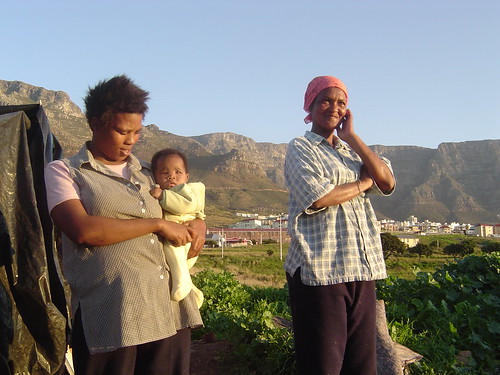Beverly Hills
Forever growing on the edges of the townships outside Cape Town are endless acres of shacks. You can see them when you drive on the highway to the airport or to Stellenbosch. It's clear from the highway that these are barely habitable homes, though its impossible to divine much more about them from the road. And, strangely, though there are shacks shoulder-to-shoulder with each other for miles along the highway, it's hard to pick out actual people in the settlements when you're speeding past at 120 km/h.
A few weeks ago, I had the chance to visit one of these so-called informal settlements and speak to some of the people who live there. This is one of the reasons I love being a reporter: even the South Africans we're friends with were amazed that I had an excuse to drop in on such a community, and more amazed that I was welcomed with open arms. This might be a sign that we need to branch out a little bit in the group of people we're friends with... but, nonetheless, I was glad to have an excuse to drop by for a visit.
The informal settlement I visited was representative of the living conditions of millions of South Africans, though this particular settlement was a bit out of the ordinary. The term "informal settlements" is the polite way of saying that the people who live there are squatters; their dwellings are illegal, and they've taken over the land by necessity and inertia, as the townships that were demarcated by the apartheid-era government have become too small to contain the mass of people flooding South Africa's urban areas. Though they're technically taking over state-owned land, this country has a severe housing crisis, and the government only makes halfhearted attempts to kick people off the land a few times before deeding them temporary status... which is a step towards the government admitting that the people who are squatting there can stay.
Most of these illegal settlements are built of the edges of government-acknowledged townships, with a group of hastily assembled shacks bulging out into a field next to a vast expanse of slightly more habitable legal buildings--legal buildings that might have such amenities as running water, or electricity.
The informal settlements usually have neither. The "homes" are one-room shacks, though even calling them shacks might be a bit generous. Shacks have walls. The structures I saw were constructed largely from plastic sheeting, like you would use for a drop cloth when painting a room. A few two-by-fours provided the frame, and corrugated tin served as a roof. Large rocks sit atop the roof; it took me ages to figure out that, with the brutal winds we get here, this wasn't as ascetic choice but a necessary one to keep the roof intact.
 The shacks I visited were a bit unusual. Instead of being built on the edges of a township, they were built in a field right in the middle of Cape Town proper, in what has to be one of the most beautiful couple of acres in the world. Table Mountain is behind them, and the smaller peaks of Lion's Head and Signal Hill are to their left. The people who live there are isolated from the world by this huge field of weeds, whose height prevents most passersby from even knowing they're there.
The shacks I visited were a bit unusual. Instead of being built on the edges of a township, they were built in a field right in the middle of Cape Town proper, in what has to be one of the most beautiful couple of acres in the world. Table Mountain is behind them, and the smaller peaks of Lion's Head and Signal Hill are to their left. The people who live there are isolated from the world by this huge field of weeds, whose height prevents most passersby from even knowing they're there.
The field is actually the former home of a vibrant neighborhood called District Six, which was the sight of an apartheid-era "forced removal." At one point it was apparently a nearly magical place, where blacks and coloureds, Jews, Christians, and Muslims all lived side-by-side in absolute harmony. It was cleared during a two-decade period when apartheid was at its peak, when the "Group Areas Act" went into effect, requiring blacks and coloureds to move out of the cities. In fact, this particular forced removal might be the most tragic, and recognizable, of the evictions after Sophiatown.
Most amusing about my visit was the discovery that the hundred or so people who live in the tall weeds of District Six had a wry sense of humor about their living conditions.
But, to explain the joke, I need to explain that it's a common practice for the squatters to come up with a name for their neighborhood. The name usually becomes accepted by the larger community, and then the government as it becomes apparent that the squatters aren't going anywhere. I think the leading name for squatter camps across the country is Mandela, with the names of the struggle leaders grabbing the other top spots.
Another common practice is to pick names of people or events in the news, so there are squatter camps called Iraq, Tsunami and Osama Bin Laden.
The last theme is my favorite, and is the one that the folks living in the shacks in District Six employed. This one involves looking around at the crappy houses, the lack of proper sewers, the rocks on the roofs and the cooking fires that stand in for proper stoves, to ponder hard about the harassment by the police, about your unemployed neighbors and your ill friends, and come up with a name that implies the exact opposite.
The one I visited was called Beverly Hills.
My article is here. My unpublished pictures from Beverly Hills are here. And don't miss my cameo in the Christian Science Monitor's daily feature called Reporters on the Job.
A few weeks ago, I had the chance to visit one of these so-called informal settlements and speak to some of the people who live there. This is one of the reasons I love being a reporter: even the South Africans we're friends with were amazed that I had an excuse to drop in on such a community, and more amazed that I was welcomed with open arms. This might be a sign that we need to branch out a little bit in the group of people we're friends with... but, nonetheless, I was glad to have an excuse to drop by for a visit.
The informal settlement I visited was representative of the living conditions of millions of South Africans, though this particular settlement was a bit out of the ordinary. The term "informal settlements" is the polite way of saying that the people who live there are squatters; their dwellings are illegal, and they've taken over the land by necessity and inertia, as the townships that were demarcated by the apartheid-era government have become too small to contain the mass of people flooding South Africa's urban areas. Though they're technically taking over state-owned land, this country has a severe housing crisis, and the government only makes halfhearted attempts to kick people off the land a few times before deeding them temporary status... which is a step towards the government admitting that the people who are squatting there can stay.
Most of these illegal settlements are built of the edges of government-acknowledged townships, with a group of hastily assembled shacks bulging out into a field next to a vast expanse of slightly more habitable legal buildings--legal buildings that might have such amenities as running water, or electricity.
The informal settlements usually have neither. The "homes" are one-room shacks, though even calling them shacks might be a bit generous. Shacks have walls. The structures I saw were constructed largely from plastic sheeting, like you would use for a drop cloth when painting a room. A few two-by-fours provided the frame, and corrugated tin served as a roof. Large rocks sit atop the roof; it took me ages to figure out that, with the brutal winds we get here, this wasn't as ascetic choice but a necessary one to keep the roof intact.
 The shacks I visited were a bit unusual. Instead of being built on the edges of a township, they were built in a field right in the middle of Cape Town proper, in what has to be one of the most beautiful couple of acres in the world. Table Mountain is behind them, and the smaller peaks of Lion's Head and Signal Hill are to their left. The people who live there are isolated from the world by this huge field of weeds, whose height prevents most passersby from even knowing they're there.
The shacks I visited were a bit unusual. Instead of being built on the edges of a township, they were built in a field right in the middle of Cape Town proper, in what has to be one of the most beautiful couple of acres in the world. Table Mountain is behind them, and the smaller peaks of Lion's Head and Signal Hill are to their left. The people who live there are isolated from the world by this huge field of weeds, whose height prevents most passersby from even knowing they're there.The field is actually the former home of a vibrant neighborhood called District Six, which was the sight of an apartheid-era "forced removal." At one point it was apparently a nearly magical place, where blacks and coloureds, Jews, Christians, and Muslims all lived side-by-side in absolute harmony. It was cleared during a two-decade period when apartheid was at its peak, when the "Group Areas Act" went into effect, requiring blacks and coloureds to move out of the cities. In fact, this particular forced removal might be the most tragic, and recognizable, of the evictions after Sophiatown.
Most amusing about my visit was the discovery that the hundred or so people who live in the tall weeds of District Six had a wry sense of humor about their living conditions.
But, to explain the joke, I need to explain that it's a common practice for the squatters to come up with a name for their neighborhood. The name usually becomes accepted by the larger community, and then the government as it becomes apparent that the squatters aren't going anywhere. I think the leading name for squatter camps across the country is Mandela, with the names of the struggle leaders grabbing the other top spots.
Another common practice is to pick names of people or events in the news, so there are squatter camps called Iraq, Tsunami and Osama Bin Laden.
The last theme is my favorite, and is the one that the folks living in the shacks in District Six employed. This one involves looking around at the crappy houses, the lack of proper sewers, the rocks on the roofs and the cooking fires that stand in for proper stoves, to ponder hard about the harassment by the police, about your unemployed neighbors and your ill friends, and come up with a name that implies the exact opposite.
The one I visited was called Beverly Hills.
My article is here. My unpublished pictures from Beverly Hills are here. And don't miss my cameo in the Christian Science Monitor's daily feature called Reporters on the Job.



0 Comments:
Post a Comment
<< Home